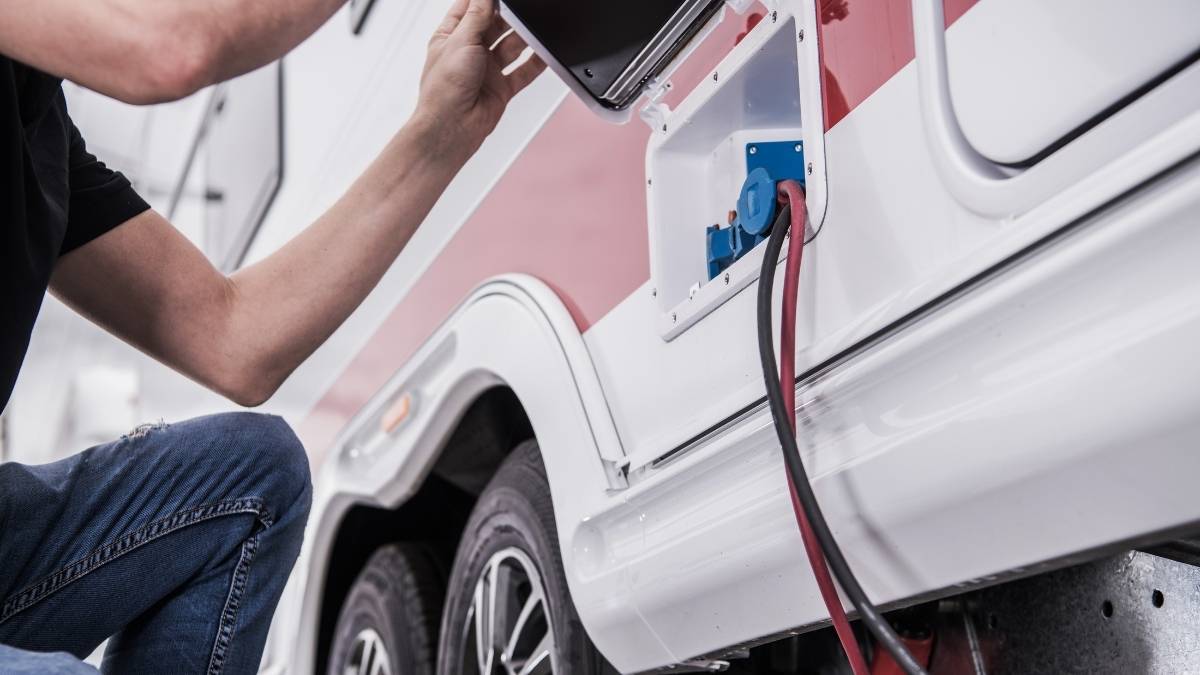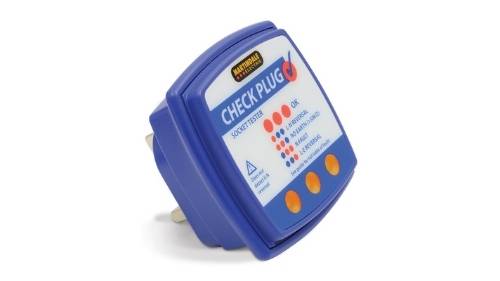Using the electric hook up supplied on powered campsites lets you charge up your leisure battery and run higher-wattage devices such as kettles, toasters, and hairdryers. Or does it?
Most campervans and motorhomes have a 12V leisure battery onboard which will offer enough power to run a small fridge, mobile phones and LED lights for a couple of days.
Going away for a longer period means you’ll most likely want to hook up to a campsite’s electrical supply.
Read on to learn what equipment you’ll need, best practices when using electricity in your motorhome or campervan and to understand how much power you use when you’re on-site
How does electric hook up work?
Campsites in the UK and Europe commonly offer both powered and unpowered pitches.
To juice or not to juice
Campers may choose to be close to nature and not use electrical power at all, be smugly self-sufficient with the 12V leisure battery in their caravan or motorhome, or take advantage of the 230V mains power supply provided by the campsite.
This article is about the latter type – campers who want to plug into the campsite electric hook up supply.
If you plug into the mains power supply it will provide power at 240V like household electricity (230V/220V in Europe). This will power appliances and will also recharge most camping vehicle leisure batteries.
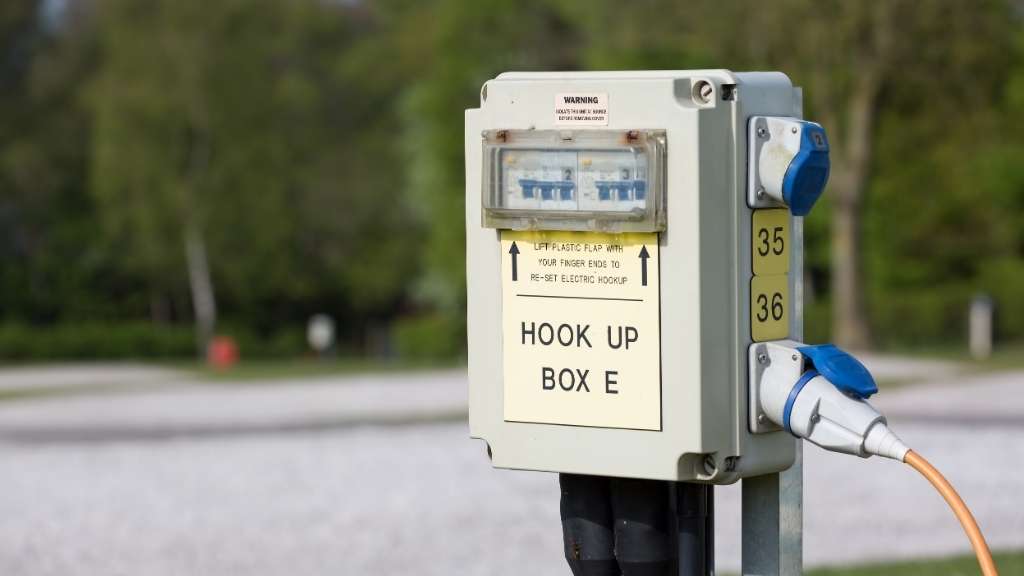
Powered pitches
The parts of the campsite with powered pitches (electric hook up) will have power supply bollards dotted around the area for campers to plug into.
Each power bollard (or EHU post) usually has one to four power connection points, although sometimes up to eight. One connection for each pitch.
Your designated power supply point may be on or next to your pitch, or it could be one or two pitches away from yours, requiring a long cable to reach it.
How much power is supplied?
Electric current capacity is measured in Amps (A). It is fairly typical for most campsites in the UK to offer either 16A or 10A on electric hook up pitches.
In Europe, this figure can be much less in some locations, offering only 5A or 6A connections.
In practical terms, this means that the power supply at the bollard produces an electrical current that can power at any one time to a maximum of 16A (or 10A or 5/6A). As the power supply user, you need to make sure your total usage does not exceed this amount.
The campsite won’t be geared up for every electric hook up pitch to use the maximum supply all at once. How much power each camper uses, especially at busy times, will potentially affect all other campers on the site.
Too many appliances drawing power at once can cause the power to trip, either locally on the bollard (cutting power to your neighbours) or potentially the whole campsite!
Electric hook up kit – what do you need?
The electric hook up gear you will need will depend on what your power usage requirements are.
To plug in your motorhome or campervan to use power in the vehicle at a UK campsite may only require a single cable. There are a few other possibilities to consider, however.
These are the main types of camping electric hook up kit.
Campsite mains hook up cable
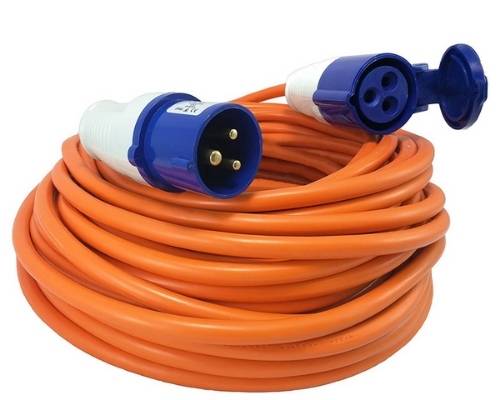
The hook up cable (or extension lead) is the main cable you’ll need to get power to your vehicle or camping unit. You must have one of these to use a campsite’s power supply.
The mains cable will have a 3-pin electric hookup male end socket to plug into the power bollard. The other end depends on whether you are camping in a tent or a vehicle.
The cables are usually brightly coloured for visibility, to stop them being trip hazards or accidentally damaged by campsite lawnmowers.
Tent vs vehicle camping
For tent camping, the mains cable will have one or more UK plug sockets and perhaps USB points at the “tent end”.
Mains cables for campervans, motorhomes, and caravans have a 3-pin campsite female end socket to plug into the van’s external electric point.
Cable dimensions
Power supply bollards can be spaced far apart, but a cable length of 25 metres will give you enough reach between your unit and the power supply at most UK and European campsites. For this reason, we would recommend going for a full 20-25m cable if you have the carrying capacity.
Your supply cable will need to conform to standard BS EN 60309-2. This specifies a PVC/PVC flexible cable with three cores, each core ideally being 2.5mm. Hook up cables are therefore fatter than your standard domestic power cords.
Cable care and storage
Your mains cable should ideally be kept in a bag or on a reel when stored and transported to protect it from damage. Make sure your cable is uncoiled before connecting the power as a coiled cable can overheat.
2 way splitter Y connector
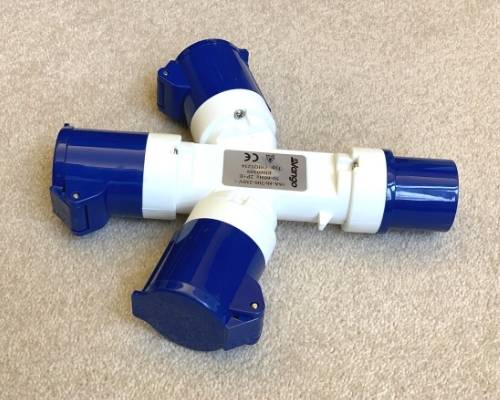
A powered pitch at a campsite will usually come with a single power supply access point. Should you wish to run more than one power cable, you will need a 2 way (or 3 way) mains hook up lead splitter.
This is an adapter which plugs directly into the power supply bollard and turns one power access point into two (or three).
We use a Y splitter if we are using our mobile mains roller power unit as well as our 25m campsite extension lead. We will only do this if we are running power to our drive-away awning in addition to our campervan.
Mobile mains roller power unit
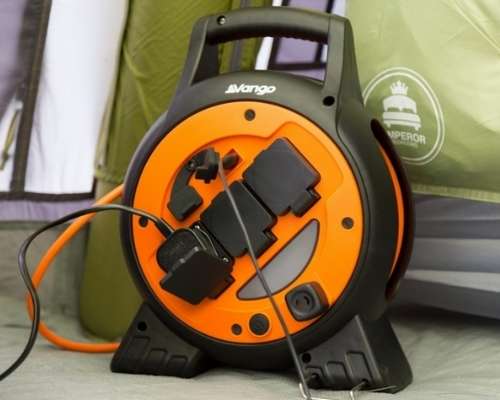
This secondary power unit is only brought along on our trip if we have the drive-away awning with us.
We use it to power lights, mobile phone charging and in cold weather a camping heater inside the awning. It has two handy USB points for charging phones, three covered three-pin sockets and a light.
This type of unit is suitable for use in a tent or awning where power will be used separately from a vehicle power supply.
UK mains electric hook up adapter
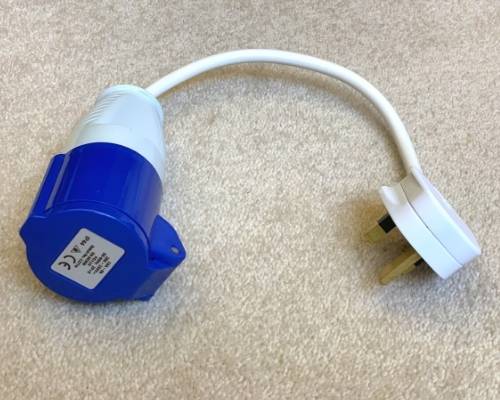
These adapters enable a campervan or motorhome user to connect their vehicle to a UK domestic 13A three-pin socket.
This is useful for testing equipment before leaving for a journey or charging the leisure battery.
It is also handy when staying at a friend or family member’s home and gives you a way of powering your internal lights, fridge, and phones without draining your leisure battery. You can also use other 230/240V electrical appliances.
The adapter connects to your extension cable cable, creating a cable with a three-pin plug, ready to plug into a domestic socket.
Definitely worth always carrying an adapter with your power extension cable so that you have the option to use a regular plug socket.
European mains lead hook up adapter
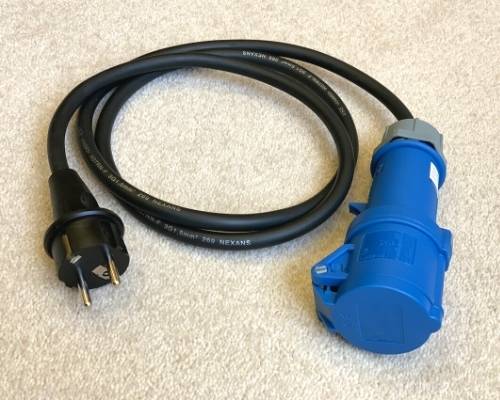
If you are travelling in Europe it would be wise to carry a two-pin European mains adaptor lead.
Electric hook up on the continent can be a mixed bag. Many sites have the three-pin camping power system as we have in the UK, some sites offer only a two-pin power supply. If this is the case you will need to use your European mains adapter to plug your extension cable into the campsite power.
The adapter will also let you plug in to a European domestic power point if this is an option.
Reverse Polarity Tester and Polarity Reverse Adapter
On European sites, there is a risk that some electric hook up posts have reverse polarity wiring.
A Reverse Polarity Tester will tell you if this is the case, and a Polarity Reverse Adapter will correct it.
When camping in Europe it seems a no-brainer to carry an RP tester and adapter. For a small outlay, it will give you extra peace of mind.
Worldwide Travel Adapter with 2 USB ports
We drive a VW California Ocean. As it is a German-made vehicle, one of the plug sockets built into the campervan is a two-pin European socket which connects to the leisure battery.
The travel adapter is similar to the type you would take away on holiday. It has four international plug options which cover over 150 countries, including the UK. It gives us the facility to charge mobile phones or tablets whilst either on the road or camped up.
We move the travel adapter when we are on-site to our single three-pin UK plug socket in the kitchen area. This gives us greater use of the socket because the travel adapter also has two USB points for charging phones or other electronic devices.
There is a blue light on the top of the adapter which is illuminated when the adapter is receiving power. This usefully acts as a nightlight, and tucked around the side of the kitchen it is not too intrusive.
Using electric hook up – best practice
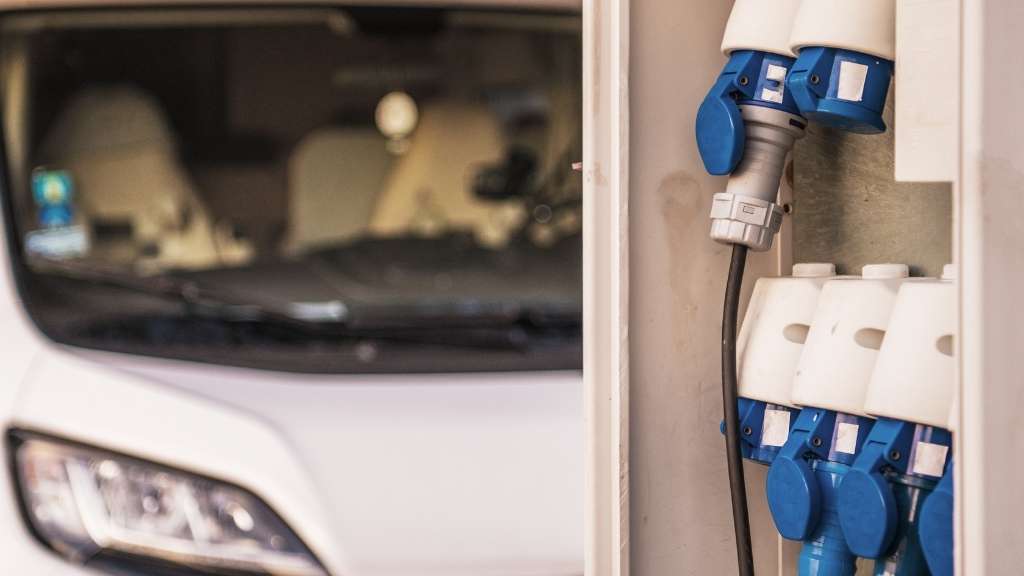
Doing anything involving electricity is potentially dangerous. It is important to use campsite power carefully and treat it with respect. Not only for safety but to protect your camping vehicle and equipment.
Ideally your van should have a switched Residual Current Device (RCD) to protect you from a potential electric shock or fire by switching off the power in the event of a fault.
Connecting to electric hook up
- Check your RCD/isolator switch is in the OFF position in your campervan/motorhome.
- Uncoil your mains extension cable fully to prevent it from overheating.
- Connect the mains cable to your van.
- Connect the mains cable to the campsite power supply bollard. This may be a push and click mechanism or a push, rotate, and click mechanism.
- Switch the van RCD/isolator to the ON position.
- If camping in mainland Europe, check for reverse polarity before using any appliances.
Disconnecting from electric hook up
- Switch the van RCD/isolator switch to the OFF position.
- Disconnect the cable from the power supply bollard. Depending on the connection type, there may be a release button.
- Carefully disconnect the cable from your campervan or motorhome.
- Store all cables carefully, on a reel or coiled in unkinked loops. Ideally, keep your extension cable in a cable bag.
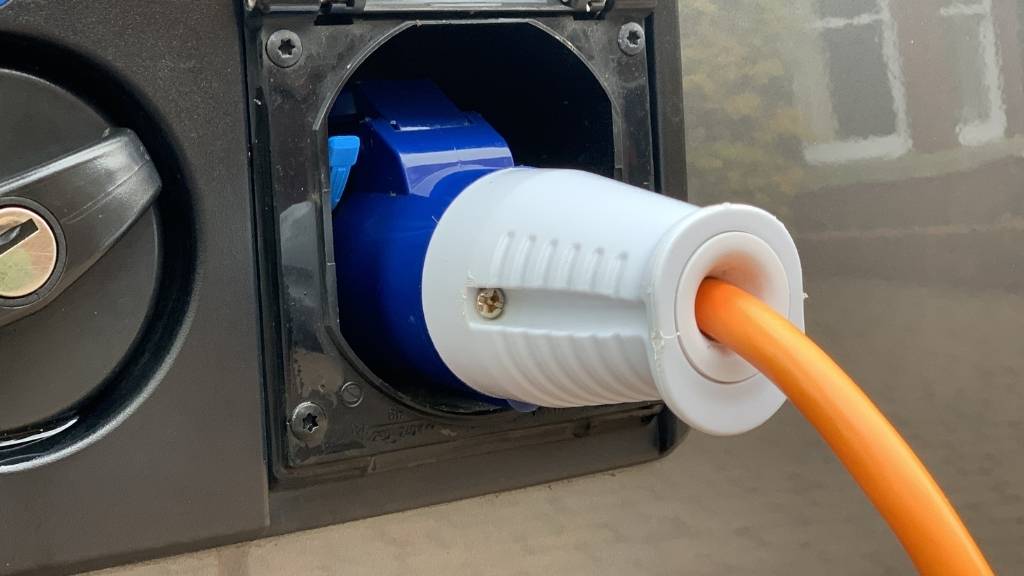
What is Reverse Polarity?
Reverse polarity exists when the live and neutral wiring has been reversed in a plug socket. This can and does happen on some European campsites.
For UK-wired vehicles, this can cause a safety issue. Power is travelling down the neutral wire rather than the live wire. This means that an appliance will work, but live power will continue to flow to it even when it is switched off.
A polarity tester (readily available for under £10) will tell you how the electric hook up is wired. Plug the tester into your van plug socket, or directly into the EHU bollard if you have the right cables. It will indicate the polarity setup with lights.
If the polarity is reversed, you should attach a Polarity Reverse Adapter to your hook up cable so that the power flowing to the van is the correct way round.
Note that you should only use the Polarity Reverse Adapter if it is definitely needed. Otherwise, you will have inadvertently created reverse polarity in your van!
How many Amps are you using?
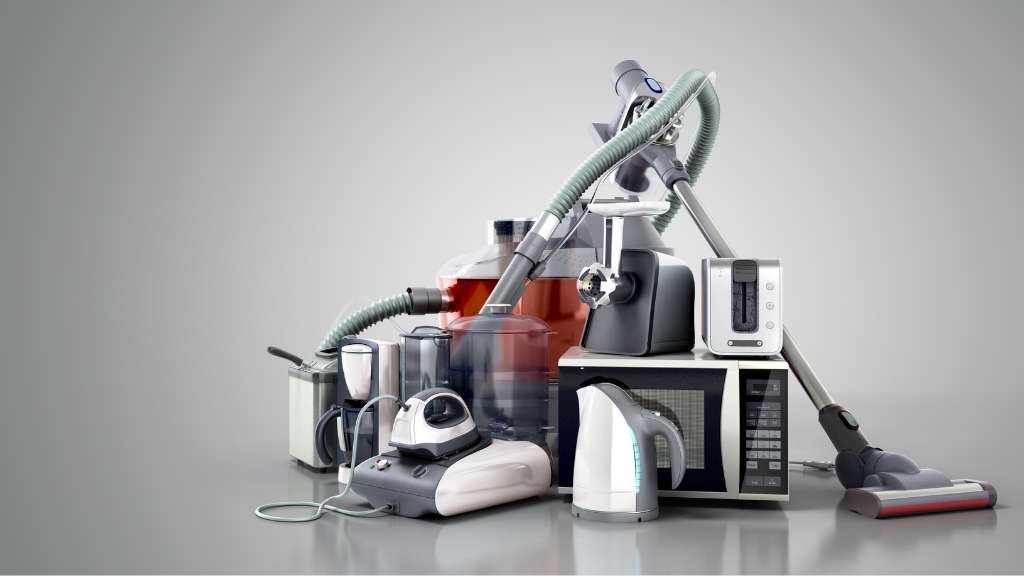
In our house, we give power usage some thought but definitely aren’t perfect. We try not to leave lights on, don’t re-boil the kettle when it’s still hot, and remember (sometimes) to shut down computers overnight.
Until researching this topic in detail, I wasn’t really aware of just how much power is used by our day to day appliances.
Power usage by domestic appliances
Home appliances can be power-hungry, and many are definitely not suitable for use on a campsite or a leisure battery.
| Home Appliance | Watts | Amps |
|---|---|---|
| Kettle | 2,500 | 10.8 |
| Dishwasher | 1,500 | 6.5 |
| Oven | 2,150 | 9.3 |
| Toaster | 2,200 | 9.6 |
| Microwave | 1,000-1,500 | 4.3 – 6.5 |
| Hair dryer | 1,500 | 6.5 |
| Flat screen TV | 100 | 0.4 |
| Iron | 2,000 | 8.7 |
Due to the high wattage used by these domestic appliances, it is not advisable to bring them onto a campsite. Instead, a low-wattage, camping friendly, version should be used.
Converting Amps and Watts
Appliances in Amps
To convert an appliance’s Watts to Amps, divide the Watts by the Voltage:
Current (A) = Power (W) / Voltage (V)
For example, an electric kettle rated as 2,500 Watts: 2,500W / 230V = 10.8A
Campsite power in Watts
It may be useful to think of your total campsite power in Watts, as this is the power unit which will be shown on your appliances.
Simply multiply the Amps by the Voltage:
Power (W) = Voltage (V) x Current (A)
16A site: 230V x 16A = 3,680W or 3.68Kw
10A campsite: 230V x 10A = 2,300W or 2.3Kw
6A campsite: 230V x 6A = 1,380W or 1.38Kw
As you can see, an average household electric kettle will draw more power than a 10A campsite supply! Leave it at home, and instead get an electric kettle designed for camping.
Power usage by camping-specific appliances
Low-wattage appliances designed specifically for camping are readily available from outdoors suppliers.
Camping appliances draw far less power than their domestic counterparts.
| Camping Appliance | Watts | Amps |
|---|---|---|
| Kettle | 1,000 | 4.34 |
| Toaster | 750 | 3.26 |
| Microwave | 800 | 3.7 |
| Iron | 1,000 | 4.34 |
| Hairdryer | 1,000 | 4.34 |
| Fan heater | 750 | 3.3 |
| Mobile phone charger | 6 | 0.03 |
| Camping fridge | 72 | 0.31 |
Electric hook up top 5 safety tips
- Remember electricity and water DO NOT mix, even when camping. Keep your plugs dry and sockets covered.
- Do not keep your cables wrapped in polythene. It is likely condensation will appear which should be avoided.
- Be mindful of how much power you are drawing at any one time. If you exceed the Amperage allowance for your pitch, you could trip the MCB switch and the power will go off. Some sites charge for reconnection.
- Keep your cables in good order and stored safely. Make sure the PVC cord is not split or showing any other signs of damage. Any doubts, discontinue use and seek advice from an electrician.
- Get the electrics in your camping unit tested regularly to ensure everything is in good working order.
